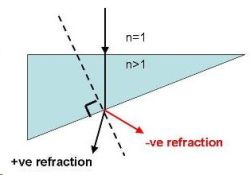Meta-materials just got easier

There was a time when nature dictated the behaviour of light, making sure it followed a few simple rules which clever people like Newton and Fraunhoufer came to understand, enabling them to take control of light with such marvels as the reflecting telescope and the diffraction grating. The clever people of today, however, are turning those well established rules on their heads and manipulating light in ways never before seen in nature. The future is one of super lenses and invisibility cloaks, all made possible by meta-materials, and these complex materials could soon be far easier to make.
Last year a team of US researchers reported in the journal Science that they could achieve negative refraction† in bulk materials comprised of silver nanowires1. The effect was demonstrated for light across a broad band of visible wavelengths, incident on the material across all angles and in which it suffered minimal loss.
Up until now, these meta-materials and others like them have been very complicated and hard to make, but researchers in Taiwan and the US have now shown how these silver nanorod materials can be made in a far easier way2,3. Using the very same vapour deposition technology which is ubiquitous in the microelectronics manufacturing industry, and a technique known as oblique angle deposition (OAD), they were able to deposit silver nanorods on silicon substrates in a relatively simple procedure.
Part of the excitement which surrounds this fabrication process is due to the fact that these photonic structures could be integrated with microelectronic components within an integrated circuit, or chip. This marriage of photonics and electronics could open up a wealth of new possibilities in communication, computing and imaging. And because OAD is a mature technology, these materials could move rapidly from being laboratory curiosities to a mass produced marketplace item.
- Optical Negative Refraction in Bulk Metamaterials of Nanowires. Jie Yao, Zhaowei Liu, Yongmin Liu, Yuan Wang, Cheng Sun, Guy Bartal, Angelica M. Stacy, and Xiang Zhang (15 August 2008) Science 321 (5891), 930. [DOI: 10.1126/science.1157566]
- arXiv:0903.1177v1
- Technique to mass produce metamaterials
† The diagram below shows a light ray passing from a medium whose refractive index, n, is equal to 1, into a material whose refractive index is greater than 1. This is the case when light passes from air or vacuum into a glass prism. When the ray exits the higher refractive index material, it will bend away from the normal to the surface (dotted line). For a left-handed material, the ray will bend in the opposite direction, as depicted by the red line. This is known as negative refraction.

Negative refraction: Light ray bends at the interface between two media of differing refractive index, n. In a left-handed material, the ray will bend in the opposite direction (red line).
 Articles published in the Optical Future's blog are licensed under a Creative Commons Attribution-Non-Commercial 2.5 Canada License.
Articles published in the Optical Future's blog are licensed under a Creative Commons Attribution-Non-Commercial 2.5 Canada License.

